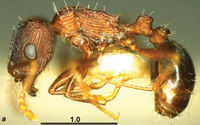Tetramorium pisarskii
| Tetramorium pisarskii | |
|---|---|

| |
| Scientific classification | |
| Kingdom: | Animalia |
| Phylum: | Arthropoda |
| Class: | Insecta |
| Order: | Hymenoptera |
| Family: | Formicidae |
| Subfamily: | Myrmicinae |
| Tribe: | Crematogastrini |
| Genus: | Tetramorium |
| Species group: | strativentre |
| Species: | T. pisarskii |
| Binomial name | |
| Tetramorium pisarskii Radchenko & Scupola, 2015 | |
Nothing is known about the biology of Tetramorium pisarskii.
Identification
Radchenko and Scupola (2015) - T. pisarskii the most resembles Tetramorium kabulistanicum, sharing with the latter the character of sculpture on the first gastral tergite. Moreover, holotype and paratype specimens of T. pisarskii were originally included by Pisarski (1967) to the paratype series of T. kabulistanicum. Nevertheless, Pisarski (loc. cit., p. 405) noted that “Workers from Hassan Guilan have somewhat coarser, but more regular sculpture than those from Cheikhabad” (out translation from French). T. pisarskii distinctly differs from T. kabulistanicum by the sculpture of mesosoma and waist: the mesosomal dorsum is with more regular, almost straight longitudinal rugae, the waist dorsum is with regular longitudinally-concentric rugae vs. the mesosomal and waist dorsum are with sinuous longitudinal rugae in the latter species. Additionally, longitudinal rugosity on the head dorsum in T. pisarskii is less coarse, number of rugae between frontal carinae level with the eyes ≥ 20 (≤ 15 in T. kabulistanicum).
Keys including this Species
Distribution
Distribution based on Regional Taxon Lists
Palaearctic Region: Afghanistan (type locality).
Distribution based on AntMaps
Distribution based on AntWeb specimens
Check data from AntWeb
Countries Occupied
| Number of countries occupied by this species based on AntWiki Regional Taxon Lists. In general, fewer countries occupied indicates a narrower range, while more countries indicates a more widespread species. |

|
Estimated Abundance
| Relative abundance based on number of AntMaps records per species (this species within the purple bar). Fewer records (to the left) indicates a less abundant/encountered species while more records (to the right) indicates more abundant/encountered species. |

|
Biology
Castes
Known only from the worker caste.
Nomenclature
The following information is derived from Barry Bolton's Online Catalogue of the Ants of the World.
- pisarskii. Tetramorium pisarskii Radchenko & Scupola, 2015: 226, fig. 5 (w.) AFGHANISTAN.
Unless otherwise noted the text for the remainder of this section is reported from the publication that includes the original description.
Description
Worker
(n = 2), ordered as: holotype-paratype: HL 0.83–0.85, HW 0.81–0.83, FW 0.34–0.33, FLW 0.37–0.36, OL 0.21–0.20, GnL 0.21–0.21, SL 0.67–0.65, ML 1.06–1.07, PNW 0.54–0.52, PL 0.33–0.35, PW 0.25–0.25, PH 0.26–0.29, PndL 0.21–0.20, PPL 0.21–0.20, PPW 0.29–0.29, PPH 0.28–0.30, ESL 0.22–0.09, ESD 0.21–0.21, HTL 0.63–0.62, rug-frons 20–14.
Indices: CI 1.02–1.02, SI1 0.81–0.76, SI2 0.83–0.78, FI 0.42–0.40, FLI 1.09–1.09, OI1 0.26–0.24, OI2 1.00–0.95, PI1 1.27–1.21, PI2 0.31–0.30, PndI 1.19–1.25, PPI1 0.72–0.69, PPI2 0.36–0.35, ESLI 0.27–0.11.
Head very little longer than wide, with somewhat convex sides, widely rounded occipital corners and very feebly concave or almost straight occipital margin. Eyes situated about midlength of sides of head, length of gena subequal to maximal diameter of eye. Scape quite strongly curved at base, without any additional structures on bent, reaching occipital margin. Frontal carinae distinctly curved and frontal lobes extended. Frons with relatively fine longitudinal rugosity, number of rugae between frontal carinae level with the eyes ca. 20. Mandibles with 5 teeth, coarsely longitudinally rugose. Surface of head between rugae densely punctated, same on mandibles smooth and shiny. Occipital margin with a few quite long suberect hairs, temples and genae without hairs.
Mesosoma with very shallow metanotal groove, propodeum with relatively long teeth widened at base, but not with thin spines. Whole mesosoma with quite coarse longitudinal, almost straight rugae. Petiole longer than high, its node transversal; postpetiole distinctly higher than long and distinctly wider than length. Petiolar node dorsum and postpetiolar dorsum with regular longitudinally-concentric rugae. Mesosomal dorsum and waist with not abundant, quite long erect hairs. Only basal half of first gastral tergite densely longitudinally striato-punctated, remainder part of tergite smooth and shiny or with fine superficial microreticulation. Head, mesosoma and waist brownish-red, appendages somewhat lighter, gaster blackish-brown.
Type Material
Holotype, worker, “Afghanistan, Hassan Guilan entre Guerechk et Dilaram, A 314, 7.9.1957, leg. K. Lindberg”, “T. kabulistanica sp. n. det. B. Pisarski”, “Inst. Zool. PAN Warszawa 43/61” (Museum of the Zoological Institute of the Polish Academy of Sciences). Paratype, worker with the same label (MIZ)
Etymology
The species is dedicated to the memory of outstanding Polish myrmecologist Prof. Bohdan Pisarski.
References
References based on Global Ant Biodiversity Informatics
- Radchenko A. G., and A. Scupola. 2015. Taxonomic revision of the striativentre species group of the genus Tetramorium (Hymenoptera, Formicidae). Vestnik Zoologii 49(3):219-244.

